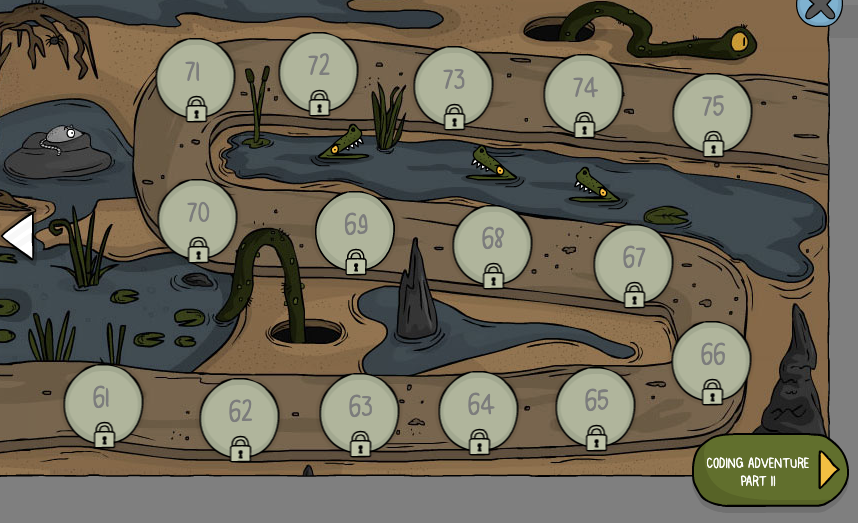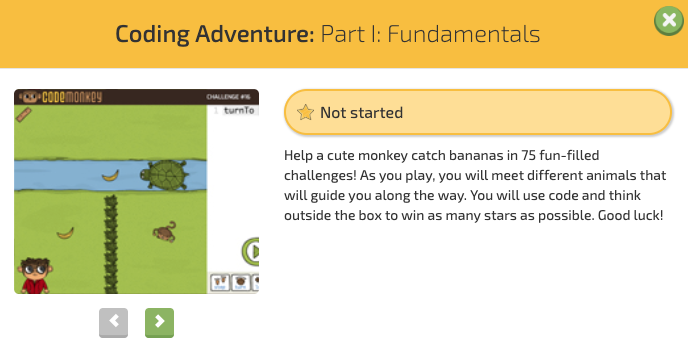If you’ve already started looking into options for helping your child learn how to code, you may have heard of CodeMonkey.
Here at CodaKid, we are big fans of CodeMonkey as a kids coding resource for a number of important reasons.
Most importantly, we think that CodeMonkey utilizes a much different approach than our own online kids coding platform, and we think that their approach can work very well especially in school environments.
In this CodeMonkey review, we’ve compiled all of the information that you’ll want to know about CodeMonkey in a helpful guide so that you can make an educated decision about your students’ education.

Table of Contents
CodeMonkey Review: Intended Audience
CodeMonkey is designed for ages 8 and up. That said, some younger children who have previous exposure to coding or who pick up on things quickly may find it suitable. As for as experience goes, users are not required to have any coding experience before playing as it will all be addressed and taught in the game.
CodeMonkey is suitable for parents seeking enrichment activities for their kids, but CodeMonkey’s real strength lies in its classroom modules.
If you are a teacher who wants to be hand-on with the education process, you can do so without any prior experience. Teaching subscriptions come with training and curriculum guides so that you have all of the material and step-by-step explanations handy.
Teachers also receive a dashboard that will help track students’ progress and see the actual code that student’s write. In addition, if you get stuck, you will always have access to technical support.
Lastly, there is good news if you are looking for lessons that aren’t in English! CodeMonkey is available in 18 languages and is working on adding more, so if for any reason you are interested in a coding resource in a different language like Spanish or French, you are still in luck.
CodeMonkey Review: Courses
There are five main courses within CodeMonkey, so there will be a variety of options to choose from. This will help maintain interest and engagement since there will be ways to change things up and also different choices to suit your child’s preferences.

Coding Adventure
This is the central course that CodeMonkey advertises, offering a wide range of challenges and fun lessons designed specifically for kids and beginners.
Coding Adventure provides text-based coding for kids with a scripting languages called CoffeeScript. The language is simple, easy to learn, and best of all it does an excellent job of communicating core computer science principles such as loops.
The game-based coding platform allows you and your students to go on adventures through different, exciting places like jungles and imaginary lands. Along the way, you’ll face over 400 challenges to rescue the bananas, all while learning foundational coding concepts.

Game Builder
This is the perfect platform for kids who want to get into computer science topics to explore their coding skills.
Game Builder allows students to:
- Build real computer games
- Remix CodeMonkey games to make a spin of your own
- Design swipe/touch interface games to work on mobile devices
- Share creations with the world
Best of all, it is self-paced and automatically assessed, so it makes for a great addition to any classroom or other educational environment.

Challenge Builder
If your students are feeling creative and want more to overcome, you can build your own challenges through Challenge Builder!
Students can build their very own challenges to practice logical reasoning, algorithms, creativity and, of course, computer programming. This is also a great way to test their knowledge of coding concepts since it takes a lot more genuine understanding to build challenges yourself.
Plus, much like with Game Builder, students can share their challenges with the world once they finish creating them.
Dodo Does Math
If you are specifically looking for programs geared towards kids still working with 2nd-4th grade common core math concepts.
Each exercise requires kids to use these concepts along with basic coding concepts to help the dodo get to her eggs. Their solutions will be shown in real-time so that they can visually follow along.
The curriculum is made up of 3 lesson plans that consist of 20 challenges surrounding addition, subtraction and distance measuring.
Coding Chatbots
Lastly, CodeMonkey also offers Coding Chatbots (aimed towards students 13+) which allows them to really enter the real world of coding.
Kids can learn how to code in python by coding a chatbot, something they will learn how to do by playing the game Snowman.
Chatbots are becoming increasingly popular, and learning how to code them can help to promote problem-solving skills and critical thinking skills that can even apply to real life outside of computer science.
Computer Science Topics Covered
Every educational website has its special focuses and approaches, and that is no different for coding websites like CodeMonkey.
First of all, knowing the programming language that you will be using with CodeMonkey is a great place to start. The program uses a language known as CoffeeScript, a great introduction to learning the more well-known JavaScript.
CoffeeScript is a language that compiles to JavaScript and is primarily used for web applications, making it a valuable language to work with for pretty much any industry.
Best of all, CoffeeScript has a much more friendly syntax than other coding languages. Since it resembles the way we write in English, it is much easier for beginners and/or young students to pick up and understand.
As far as computer science subjects, CodeMonkey has a range of topics that they cover throughout their challenges, including:
- Objects
- Function calls
- Loops
- Arrays
- Arguments
- Variables
- Keyboard and mouse events
- And more!
Plus, they are constantly working to expand the program and introduce even more products, so there will likely be more to look forward to in the near future.
Technical Requirements
One of the most convenient aspects of CodeMonkey is that it doesn’t require any software downloads to play. It is completely web-based and can be used anywhere with WiFi.
Aside from internet access, the only requirements that you need to keep in mind is that if you are using it on a desktop or laptop, you need to make sure that you have a relatively up-to-date version of Firefox, Chrome, Safari or Internet Explorer.
If you are using it from a tablet, make sure that you are using a relatively new device that can handle the program. A good rule of thumb is making sure that it is a product released in the last two years.
Do keep in mind, though, that if you do want to use tablet devices, only about 165 challenges and the correlating skill mode challenges are available for tablet play.
Pricing
There are a number of different plans with CodeMonkey, ensuring that you’ll get the one that works best for you and the children in your life.
Homeschool
This option costs $109/yr and is specifically designed for private tutoring and small groups, whether these groups are your own children or simply private students.
This package permits up to 3 students and 1 teacher, and it includes 6 activities (400+ challenges) which consist of 3 math activities, 3 game builder courses and even 1 python course.
Super Teacher
This plan is less expensive at $49/yr and is also suited for much larger groups, making it perfect for classrooms or large tutoring groups.
An unlimited number of students are allowed on this plan as well as 3 co-teachers, but the structure only includes 1 activity (30 challenges). It’s much better as an overview package for larger groups rather than an in-depth one for select students.
Custom School Plans
For schools looking into adding coding to their core curriculum, CodeMonkey will offer quotes that match your specific situation.
The only requirement is that you have at least 20 students intending to use the program. It allows for multiple co-teachers while offering the same content as the Homeschool plan. Best of all, it includes a personal contact at CodeMonkey to promote professional development for instructors as well as any assistance in answer questions or problems.
In Summary
That about covers pretty much every main area and detail about CodeMonkey, so hopefully your general idea and view feel much more secure and informed.
To recap, we have discussed:
- Intended audiences
- Courses
- Gameplay
- Topics covered
- Technical requirements
- Pricing
- And bonus answers to FAQs
We know that the #1 priority for you is making informed decisions about your child’s education, whether it be directly related to their classes in school or perhaps to more supplemental opportunities and information. Hopefully we’ve helped provide some insight so that you can be more comfortable in those decisions.
So, what are your thoughts on CodeMonkey? How might you incorporate it into your child’s education?

















